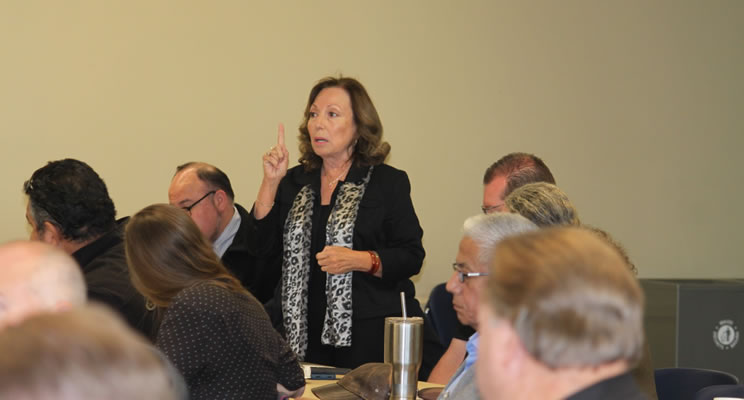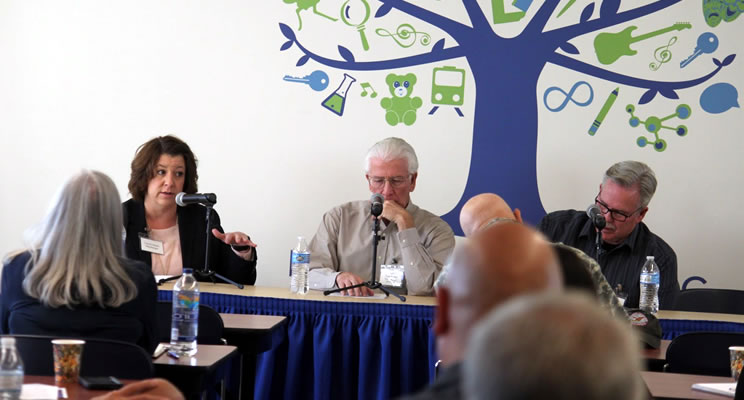Above photo: Cheryl Marie Hansberger, Chief of Staff-City of Riverside, speaks about partnerships to end homelessness. Photo credit: SAWPA
On Thursday, December 7th the water sector, homeless service providers, and elected officials took the lead in ending homelessness in the watershed. As they filled the room of the Conference Center at the Fullerton Library, an excited buzz filled the air. Over one hundred leaders of water agencies, policy makers, and local non-profit employees shared with one another their eagerness to hear how they can help end homelessness. Following their successful homelessness and water symposium last June, Inland Empire Waterkeeper and the Santa Ana Watershed Project Authority (SAWPA), once again brought together water agencies and homelessness service providers to openly discuss ways collaboration can end homelessness in the Santa Ana Watershed once and for all.
The event opened against the backdrop of the beautiful historic building with a lush green lawn, dotted with homeless individuals, their backpacks and bedrolls fastened to them as they prepared to move on from their temporary sleeping quarters. Inside, discussions on partnerships between water managers and homeless service providers sparked renewed hope for a solution . The City of Riverside Chief of Staff, Dr. Cheryl Marie Hansberger, presented on current partnerships with various non-profits, social service providers, as well as faith-based organizations to connect individuals experiencing homelessness to social and housing services while addressing the trash and other sanitary issues associated with homelessness. Hansberger discussed in depth, the Riverside at Work program, which educates, trains, and connects formerly homeless individuals to businesses that will consider hiring them. Similar to the Riverside at Work program, OC United’s Jobs for Life provides homeless individuals with an eight week, 32 hour job training course at the Kraemer Place Shelter, according to Director Mike Carman of OC United.

- County of San Bernardino Board of Supervisor, Josie Gonzales, addresses the room from the audience. Photo credit: SAWPA
Discussions on the Human Right to Water moved San Bernardino County Board of Supervisor and homeless czarina, Josie Gonzales, to speak on the issue. Supervisor Gonzales believed the answer to ending homelessness was in “this” room and that we “must partner with water. We can survive without housing, we have the proof with our homeless issue, we cannot survive without water. We can use water as a unifier,” the Supervisor said as she stood from the audience in an impromptu speech.
Representatives from LA County Health Services, OC Health Care Agency, and the non-profit organization, Illumination Foundation, discussed the state of homelessness with a focus on public health. Paul Leon, CEO and President of Illumination Foundation, was moved to tears as he recalled the moment he bandaged a homeless individual and how the man experiencing homelessness was in complete disbelief that he was worthy of a brand new bandage.
Megan Brousseau of Inland Empire Waterkeeper was the keynote speaker. Brousseau unveiled a new program that will improve living conditions and the water quality of the Santa Ana River within the middle stretch in Riverside. The Clean Camp Coalition will provide a trash collection service to individuals experiencing homelessness at three heavily encamped sites along the Santa Ana River. This program was created in 2017 as a way to create partnerships between water agencies and homeless resource agencies. The Clean Camp Coalition aims to create an immediate improvement on local waters, the environment, and the health of individuals experiencing homelessness. It seeks to alleviate the water quality issues in our waterways caused by debris from encampments along the Santa Ana River. Furthermore, it seeks to provide individuals experiencing homelessness with resources for housing and employment opportunities. “
Brousseau said, “those of us in the water sector have traditionally treated homelessness as a point source pollution issue, trying to identify and then eliminate the human source of pollution. That has not and will not work. It’s our issue, and we have to take the lead and the responsibility to end homelessness in this river and watershed with compassionate, housing first solutions that can only come from a diverse coalition of partners.”

